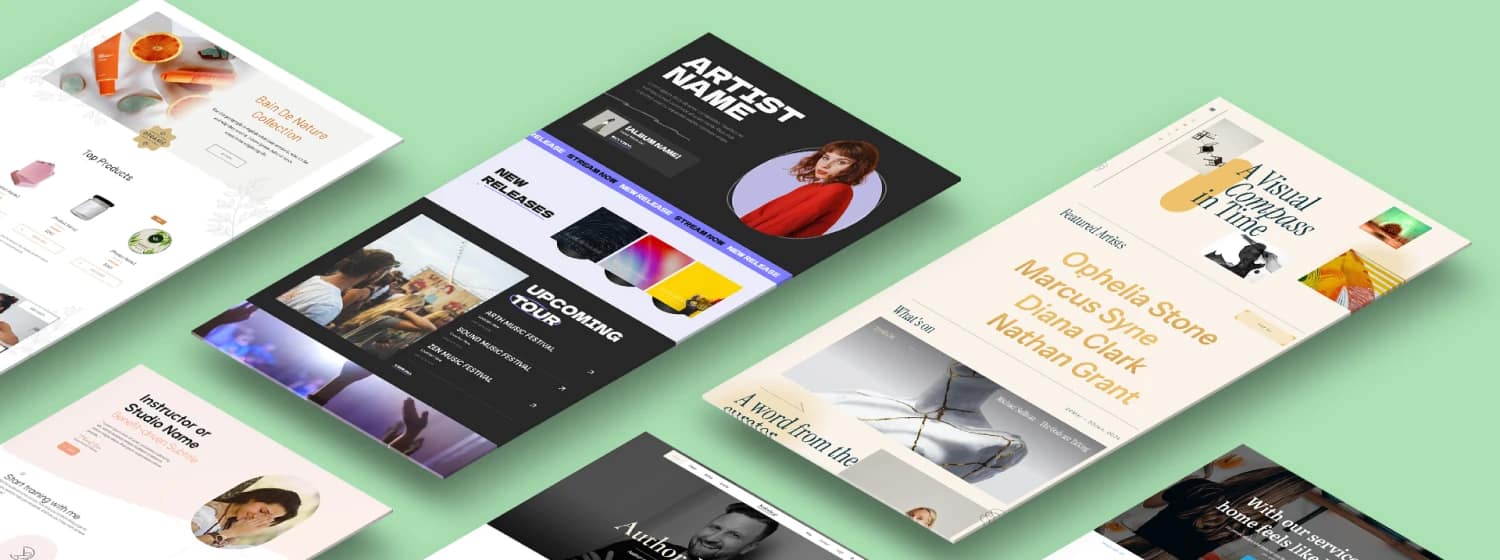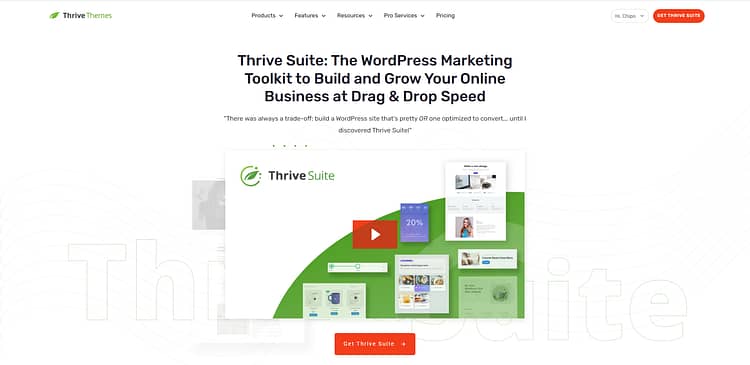TL;DR: What Are the Best Coaching Landing Page Examples Doing Right?
There are a lot of coaches out there — and even more opinions on what your website should look like. If you’re not sure whether your landing page is working — or you haven’t built one yet — this guide clears things up fast. Here’s what you’ll learn (and what actually works):
- What makes a coaching landing page effective?
A single, focused offer — like a free call, quiz, or training — backed by a benefit-driven headline, real proof, and a clear CTA. The best pages don’t distract — they guide. - What should I put on my landing page?
Start with a promise (what result you help people achieve), then add social proof, testimonials, credibility markers, and a strong reason to act now. Repeat your CTA at least 2–3 times. - Should I offer a freebie, quiz, or discovery call as my coaching offer?
Depends on your business model — most high-ticket coaches lead with a call. If you’re growing your list, try a quiz or lead magnet. You’ll see real examples of all three inside. - Can I build good landing pages without a designer?
Yes. Every page in this guide was made with simple tools like Thrive Suite. You’ll get access to drag-and-drop templates made for coaches — no coding needed. - How do I know if my landing page is working?
Track conversions. If people are clicking but not signing up, your copy or offer might need a tweak. Thrive Suite includes tools to test variations and improve results.
This guide breaks down 7 real coaching landing pages, so you can skip the guesswork — and build a page that looks good, feels aligned, and drives action.
If you’re a coach, your landing page is either working for you… or quietly working against you.
It’s the page people land on when they’re most curious — and most uncertain. And in a few scrolls, they’ll either trust you enough to take action… or they’ll bounce.
The problem, however, is the fact that most coaching website landing pages don’t convert. They aren’t even designed to.
They ramble. They try to do too much. Or they feel more like an online résumé instead of a conversion-focused landing page.
Meanwhile, the coaching industry is exploding:
- The global coaching market is now worth $6.25 billion
- It’s projected to hit $7.3 billion by 2025
- Active coaches worldwide? Over 145,500 today, with 167,000+ expected next year
- Annual revenue has jumped 60% since 2019
That means more opportunity – but also more noise.
If your life coach landing page, health coaching funnel, or business coaching lead magnet isn’t clear, focused, and built to get those clicks… someone else’s will be.
And you might be thinking “Maybe I need a new coaching template…”
You don’t. In fact, I’m 99.9% confident that your current page is fine. It just needs a few simple tweaks to turn it into a high-converting landing page.
That’s what this post is about.
You’ll see 7 real-world effective coaching landing page examples that do extremely well — with breakdowns of why they work and how to adapt the ideas to your own offers.
And if you want to build yours fast? You’ll get the tool recommendations and page types I recommend and have used over the years – built for coaches who want results, not just a pretty page.
Let’s dive in.
Coaching Landing Page Examples: The Answers You’re Looking For Right Upfront
Before we dive into real examples, let’s answer the big questions coaches are actually asking.
Because when your landing page isn’t converting, it’s rarely about colors or font choices — it’s about clarity, structure, and strategy.
This section breaks down what makes the best coaching landing page examples work in 2025. You'll learn what types of pages convert best, what goes into a high-performing design, and what tools will get you there faster.
Whether you're starting from scratch or trying to fix an underperforming page, this is where to begin.
A strong coaching landing page keeps things clear and focused. Right at the top, you’ll want a headline that speaks directly to the result your audience wants – something practical, not vague or generic.
Then guide visitors toward one specific action, like booking a free session or downloading a resource. Add trust elements like testimonials, credentials, or media mentions. And make sure your page works well on mobile — with fast load times and a clean, scroll-friendly layout.
A good page doesn’t try to say everything. It delivers the right message at the right time and moves people forward with confidence.
The most effective coaching pages usually fall into a few core types:
- Free consult or strategy session pages for high-touch coaching
- Lead magnet opt-in pages that offer valuable tools or guides
- Webinar registration pages that build authority and urgency
- Quiz funnels that segment leads and build engagement
- Challenge pages that drive action through time-based momentum
- Video sales letter pages that use storytelling to build trust
The format you choose should match what you’re offering and how ready your audience is to take action. The clearer the purpose, the better your results.
This guide includes 12 coaching landing page examples that are working today — not just because they look good, but because they’re built with intention.
You’ll see:
- A workshop registration page that uses bold copy and urgency
- A masterclass funnel that combines proof, pacing, and a strong CTA
- A consult application page with strategic filtering questions
- A podcast-driven opt-in that captures interest from a warm audience
- A lead magnet page with hyper-targeted messaging and proof
- A story-based video page that creates immediate connection
Each one is broken down step by step so you can apply the same thinking to your own coaching offers.
Start by deciding exactly what action you want visitors to take. Then build your copy around that goal, using simple, benefit-driven language.
Replace generic lines with specific outcomes. Add one primary CTA and repeat it more than once throughout the page. Use visual proof — like a photo, a testimonial, or a stat — to reinforce trust.
Make sure your layout flows smoothly on mobile and loads quickly. Then test one element at a time (like your headline or button copy) to see what improves performance. You don’t need to redesign everything — small, focused changes go a long way.
Thrive Suite is an all-in-one platform that makes it easy to build coaching landing pages that actually perform.
Thrive Architect gives you full design control with drag-and-drop editing, while the built-in templates give you a head start — especially if you’re not a designer.
You’ll also get access to tools like:
- Thrive Leads (for building your email list)
- Thrive Quiz Builder (for qualifying leads)
- Thrive Apprentice (for running courses or programs)
- Thrive Optimize (for A/B testing your landing pages)
You can build an entire coaching funnel, from lead magnet to course delivery, without switching platforms or learning code. It’s flexible, fast, and built with real-world marketing in mind.
This is Why Most Coaching Pages Don’t Convert
Before you copy what other coaches are doing, you need to understand this: most coaching landing pages aren’t converting — even the “pretty” ones.
There’s a reason your traffic might not be turning into calls, downloads, or sign-ups. And it usually comes down to a handful of avoidable mistakes that weaken trust and confuse your visitors.
Let’s break it down.
What’s Holding Most Coaching Pages Back?
Vague, feel-good headlines with no value hook
Visitors land on your page hoping to hear: “Here’s how this helps me.” But instead, they get vague lines like “Step Into Your Power” or “Unlock Your Potential.” These don’t clarify what you offer or why it matters — they just float past the reader. Clarity beats inspiration every time.
Multiple CTAs that compete for attention
“Book a call,” “Join my newsletter,” “Download the checklist,” “Follow on Instagram” — all on one page. This kills conversions. A high-performing landing page has one job and one next step. Anything more introduces friction and decision fatigue.
Weak or buried testimonials
Your visitors need proof that your coaching delivers. If your testimonials are generic (“She changed my life!”), hidden at the bottom, or missing entirely, you’re asking people to trust without evidence. Real testimonials with specific outcomes build trust fast.
Layouts that look like homepages
A homepage says “here’s everything I do.” A landing page says “here’s what to do next.” If your page has a nav bar, random sections, or sidebars full of distractions, you’re not guiding your visitor — you’re losing them.
No urgency or clear next step
Even if someone’s interested, they won’t act unless you give them a reason to act now. That could be a limited-time offer, a next-available booking slot, or even a well-placed CTA button that says exactly what happens next. Without urgency or clarity, momentum dies.
🚨 Here’s What Happens If You Don’t Fix It
What’s the cost of a coaching landing page that doesn’t convert?
When the right people land on your page and still don’t take action, it’s rarely about your niche, your price, or your credibility. It’s how the offer is being presented.
Because even with visibility, good content, and steady traffic, a page that’s vague, cluttered, or too polished can quietly push people away. You don’t always notice it in the moment — but over time, it adds up.
And the data backs this up:
- Average landing page conversion rate: around 6.6%
- Top-performing pages: convert at 10% or more
- Mobile bounce rates can climb as high as 51% if your layout isn’t optimized
- Bounce rates increase by 123% for every 10 second delay in a page’s load time
None of these numbers are extreme on their own. But together, they create a slow leak — one that holds back your list growth, your bookings, and your revenue.
And with an estimated 145,000+ active coaches today (and more entering every year), you can’t afford a page that simply looks good. It has to convert.
And that’s what the next steps are about: showing you what works so you don’t become a negative statistic. You don’t need to start from scratch. You just need to fix what’s not doing its job.
Let’s keep going.
Big Breakdown: 7 Top Coaching Landing Page Examples That Nail It
So what does a high-converting coaching landing page actually look like in 2025?
It’s one thing to talk about headlines, CTAs, and page flow, but it’s another to see how real coaches are putting those principles into practice.
In this section, I’ll break down 7 coaching landing pages that are doing it right. Each one is different – from freebie opt-ins to premium call funnels – but they all follow a clear logic: focus the message, guide the action, and earn the click.
Use these examples as inspiration, swipe files, or even a mirror for your own page. The goal isn’t to copy — it’s to see what’s possible when strategy meets clarity.
Example 1: Susie Moore – The Self Coaching Society Landing Page
🧭 Type: Premium Coaching Program
🎯 Offer: The Self Coaching Society – A Path to Emotional Resilience & Confidence
TL;DR: What Susie Moore’s Coaching Page Gets Right
Susie’s page leads with clarity and emotional resonance. From the first headline, it speaks directly to the reader’s inner world. No vague “live your best life” language, just grounded, uplifting copy.
A few standout moves:
- The headline sets the tone – simple, personal, and instantly relevant: “You deserve to be excited about your life.”
- Her face is front and center, building trust before the reader even scans a testimonial. This is especially effective for coaching where the relationship matters.
- The “What I’m Not” section filters with kindness, helping visitors self-select without feeling excluded. It’s smart positioning that also builds relief and respect.
- Her coaching method is clearly explained – not buried in rambling sentences with no value, but laid out so the reader believes in the process before ever clicking the CTA.
- She includes the price confidently and without friction, which signals transparency and avoids sticker shock later.
- Testimonials are woven throughout, each one echoing real transformations. Each one reinforces the page’s promise at key decision points.
Overall, this is a great example of a premium coaching page that doesn’t just describe the offer — it builds belief in it. And it does so with structure, warmth, and total clarity.
Susie Moore’s landing page for The Self Coaching Society is a masterclass in building warmth and authority at the same time. From the moment you land on it, there’s no question who it’s for or how it’s meant to feel. This isn’t a generic coaching template. It’s a carefully constructed, emotionally intelligent page that speaks directly to the reader’s inner life.
The hero section makes an immediate impression — both visually and emotionally. The headline (“You deserve to be excited about your life.”) doesn’t hide behind jargon or vague transformation promises. It’s simple, direct, and emotionally charged. That tone carries through the rest of the page. Every line of copy is crafted to nudge the reader toward hope and curiosity. And I love that.
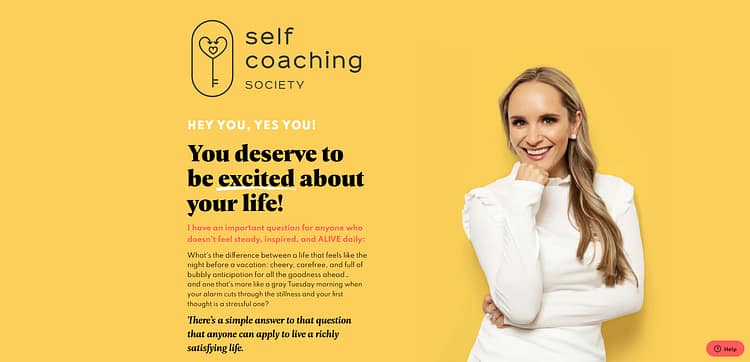
What I think really works is how personal the page feels. Susie’s face is prominent, not tucked away in a small corner — and for coaches, this is essential. The buyer needs to trust the person behind the offer, especially when the product is deeply personal like life coaching. Her presence builds connection before any credentials are even mentioned.
From there, the page unfolds in layers — with social proof, philosophy, and clarity all working in tandem. She includes major media logos, which add credibility. But the storytelling doesn’t rely on status. Instead, Susie shares her personal story, her outlook on coaching, and what you can expect from the program in an approachable, no-fluff voice. That balance — between aspirational and relatable — is hard to pull off, and she nails it.
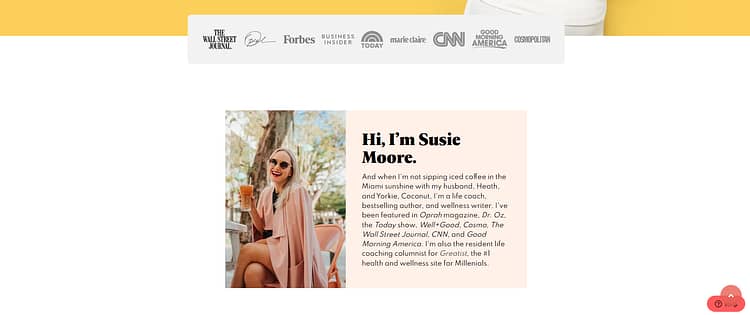
One of the most effective parts of the page is her “What I’m Not” section. Instead of only trying to sell the dream, she makes it crystal clear who this isn’t for. That’s not just honest — it’s brilliant positioning. It makes the reader feel safe. Coaches often forget that a big part of conversion is relief. Relief that they’ve finally found someone who gets them. Relief that they won’t waste time or money on something that’s not aligned. Susie offers that.
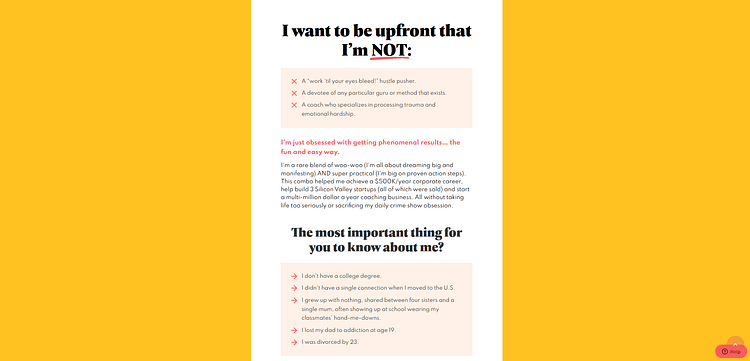
The page also does an excellent job of breaking down her actual method — the unique philosophy behind The Self Coaching Society. It’s not buried. It’s front and center. She doesn’t just say “transformation happens.” She shows how it happens. That builds belief in the process before the CTA even appears.
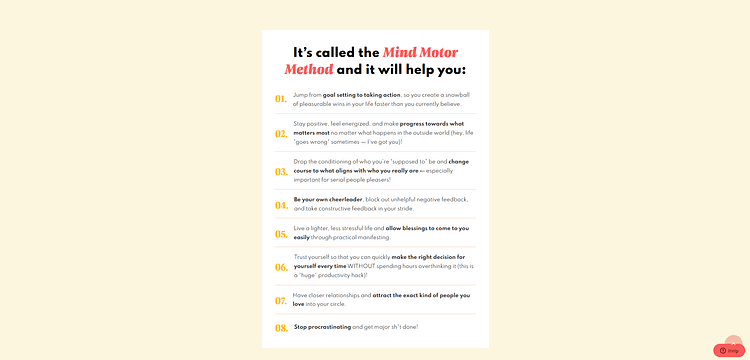
Speaking of CTAs — she doesn’t hide the price. That alone puts her ahead of many high-ticket coaching pages. She’s direct about cost, value, and what you get. There’s a level of transparency here that builds trust instantly.
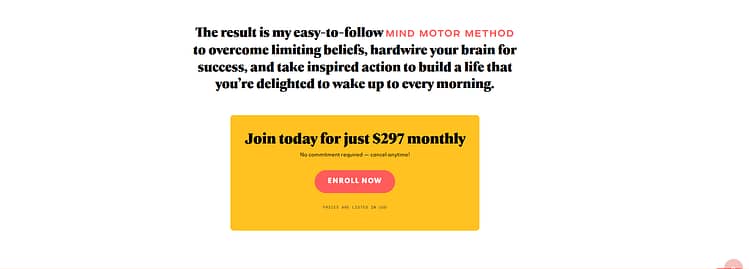
Throughout the page, testimonials are scattered in smart, intentional ways. Instead of dumping them all at the bottom, she weaves them into the flow of the offer. These aren’t generic “Susie’s great” statements. They’re outcome-driven, emotionally resonant pieces of social proof. They reflect the results she promises — more confidence, more self-trust, more emotional clarity.
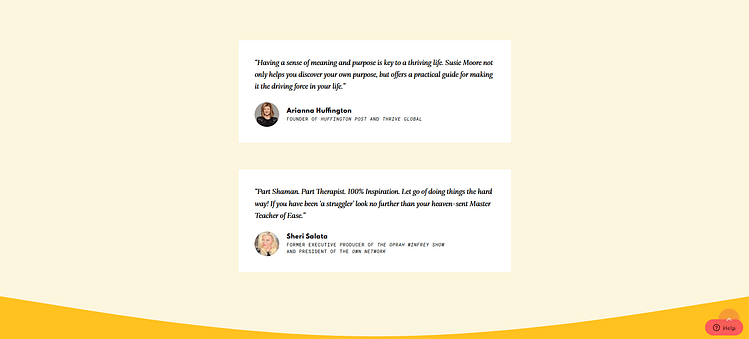
This is a high-conversion coaching page because it doesn’t just inform — it connects. The structure is intentional, but the copy still feels warm. It’s aspirational, but grounded in proof. If you’re a coach creating a premium offer, there’s a lot to learn from how this one is done.
🔑 Key Takeaways from Susie’s Self Coaching Society Page
- Lead with transformation, not tactics. The headline hits straight to the emotional core of the offer.
- Use your face — early and prominently. Trust starts with visibility.
- Don’t fear honesty. Her “What I’m Not” section builds more trust than fake hype ever could.
- Name and explain your framework. The breakdown of her process adds credibility and clarity.
- Repeat testimonials with purpose. Don’t just stack praise — highlight outcomes that align with your promise.
- Be transparent with pricing. Especially at higher tiers, clarity converts more than mystery.
- Warmth + structure = trust. The page flows naturally, but every section has a clear role in the conversion path.
Example 2: Marie Forleo – Free Productivity Masterclass
🧭 Type: Free Productivity Masterclass
🎯 Offer: “3 Sneaky Mistakes That Kill Productivity & Tank Profits” – Instant Access Training by Marie Forleo
TL;DR: Why Marie Forleo’s Masterclass Page Works
This is a short landing page that punches way above its word count. If you’re offering a free masterclass, lead magnet, or webinar, this is the kind of page you should study.
- It opens strong with a clear, benefits-focused headline:“3 Sneaky Mistakes That Kill Productivity & Tank Profits.”There’s no fluff, no guesswork — just a specific problem and a reason to keep reading.
- The CTA promises immediate value:“Watch INSTANTLY” replaces vague language like “Sign up now.” That single word — “instantly” — lowers friction and raises trust.
- Her photo builds connection, and the content block next to it breaks down the value with zero overwhelm:
- What you’ll learn
- Why it matters
- How it fits into her Time Genius method
- Trust signals follow immediately, using major media logos (Oprah, NYT, Forbes, Goop) to signal authority. If you don’t have this level of PR yet, this is where solid testimonials or recognizable client brands can do the job.
- There are just two CTA buttons, placed exactly where momentum peaks — one above the fold, and one after the proof.
This page doesn’t try to do everything. It just makes it ridiculously easy to say yes.
Let’s keep this one short because that’s the entire point of Marie Forleo’s landing page.
Unlike high-ticket coaching program pages that go deep with testimonials, storytelling, and objection handling, Marie’s page is just one clear, focused scroll. It’s a masterclass in restraint. And if you’re offering something free — like a webinar, challenge, or lead magnet — take notes.
The hero headline hits hard:
“3 Sneaky Mistakes That Kill Productivity & Tank Profits.”
It’s specific, punchy, and immediately relevant to business owners who feel like they’re spinning their wheels.
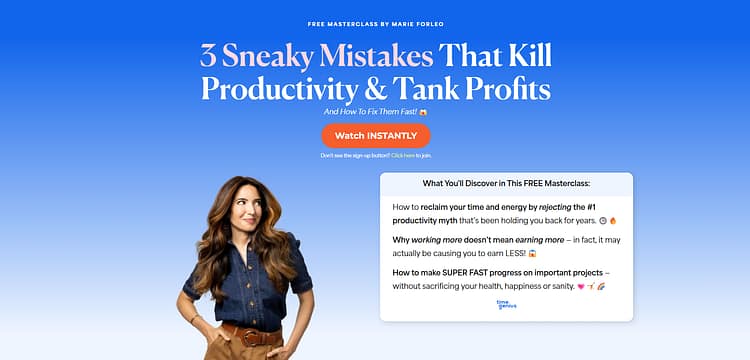
Then, right beneath it:
👉 A bold CTA: “Watch INSTANTLY”
This does a couple of smart things. First, it removes friction. There’s no “register now” or “join the list.” It promises value immediately, which builds trust and encourages clicks.
Next to Marie’s smiling photo is a single value box:
It’s well-spaced, easy to skim, and has just enough depth to feel worth opting into.
And right after that? Social proof — not testimonials this time, but logos: Oprah, Forbes, Goop, NYT. If you haven’t been featured like this (yet), this is where testimonials from real people with results can step in.

What I really want you to take from this is:
Not every coaching page needs to be long.
If you’re giving away something free, let the simplicity do the work. A few smart copy lines, visual cues, and trust signals are more than enough to convert curious visitors into subscribers.
Also: Marie includes two CTA buttons, one in the hero and one after the proof section. Even on short pages, placement matters.
🧠 Key Takeaways: What You Can Learn from This Page
- Match the page length to the offer. Free = low commitment, so keep it concise.
- Use instant access language. “Watch instantly” feels modern, friction-free, and satisfying.
- One value box > bloated paragraphs. Get to the point fast, then invite action.
- Don’t overdesign. This page is minimal but effective because it stays out of its own way.
- Use whatever social proof you do have. If you haven’t been on Oprah, real testimonials work beautifully.
And if you need guidance on how to collect and display testimonials on your website, check out this detailed guide.
Example 3: Ali Abdaal – LifeOS Coaching Program Landing Page
🧭 Type: Premium Productivity Coaching Offer + Curriculum-Based Course
🎯 Offer: LifeOS – A Complete System for Personal & Professional Growth
TL;DR: Why Ali Abdaal’s LifeOS Page Converts with Confidence
Ali’s LifeOS page feels less like a funnel and more like a thoughtful walkthrough — built for readers who want clarity, not coaxing.
- The headline leads with truth, not tricks:“LifeOS: A complete system to help you live a happier, healthier, more productive life.”It sets the tone. No overblown hype — just a direct promise that resonates.
- The opening insight section does the heavy lifting:Before he ever talks about features, Ali unpacks the why behind productivity struggles. That tiny shift — teaching first — makes his offer feel like the answer, not just another product.
- His curriculum layout is a masterclass in visual clarity:Icons, short benefit-led descriptions, and modular blocks make it scannable but persuasive. It’s the kind of section that makes people think, “Yes, I need this.”
- FAQs are robust and realistic:From tech questions to emotional hesitations, he tackles real objections before they become dealbreakers.
- The final CTA is understated but effective:No countdown timers, no pushy language. Just an invitation backed by value — and it works.
If you’re building a high-value coaching or digital product page, this one is worth studying from top to bottom.
Let me just say, Ali Abdaal’s LifeOS landing page is an excellent case study in high-conversion design that still feels human and clean. You can tell from the first scroll that this isn’t a slapped-together funnel — it’s strategic, but still Ali.
The first thing that stands out? The headline and intro section. It doesn’t waste time trying to be overly clever — it just says exactly what this is:
“LifeOS: A complete system to help you live a happier, healthier, more productive life.”
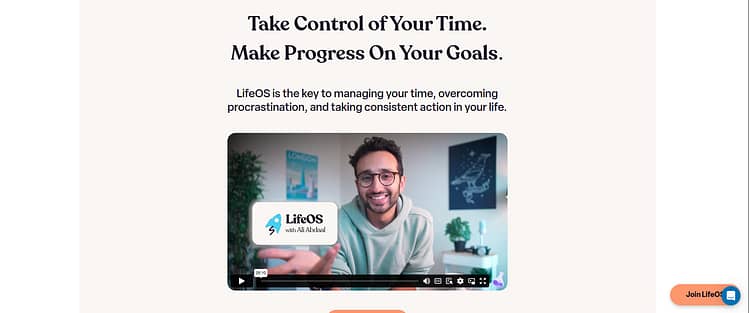
Then, instead of rushing into features, Ali offers a mini philosophy lesson. He unpacks the psychology behind why productivity systems fail — which subtly positions LifeOS as the smarter solution *before* he even pitches it. That’s a powerful tactic for coaches selling premium programs: lead with insight, not offers.
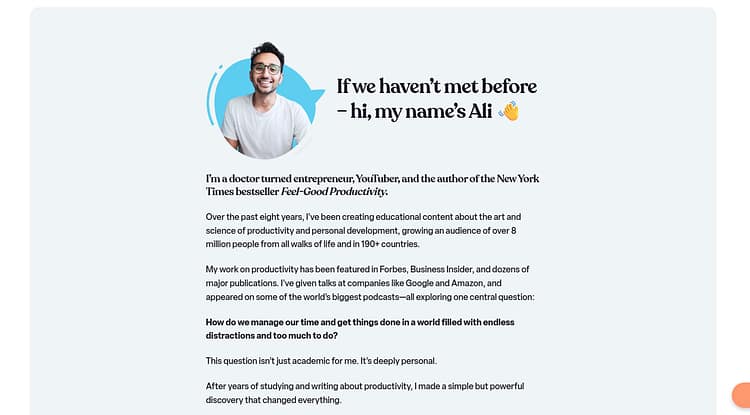
Next, the breakdown of what you get is clean, benefit-led, and deeply visual. Every part of the curriculum — from energy tracking to intentionality and workflow — is laid out with icons and copy that makes it easy to skim but hard to ignore. If you’ve ever struggled to structure your coaching curriculum page, just look at how this one simplifies a complex offer.

I also love how he includes a full section on “Who This Is For” and “Who It’s Not For”. Coaches, please don’t skip this. Not only does it help filter out the wrong audience (which saves you time), it actually builds *more* trust with the right ones. Transparency converts.
Then there’s pricing, which is clearly displayed — no hiding it behind a sales call. The “one payment or three” model is simple, and the copy underneath it directly tackles objections (e.g. “you can go through the entire program and still get a refund if it’s not for you”). This matters. High-ticket doesn’t mean high-pressure.
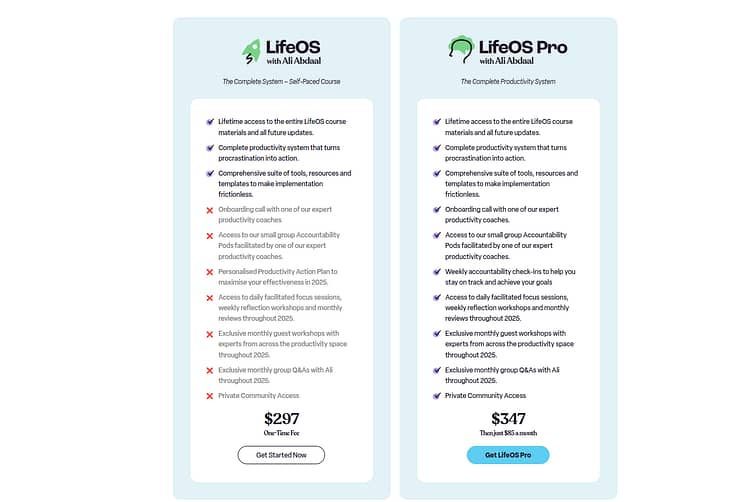
The FAQs section is another strength. It’s long, detailed, and covers both logistical and emotional questions. Things like “Will this work if I’ve already tried other productivity tools?” show he knows exactly what doubts the buyer has — and he’s not afraid to address them.
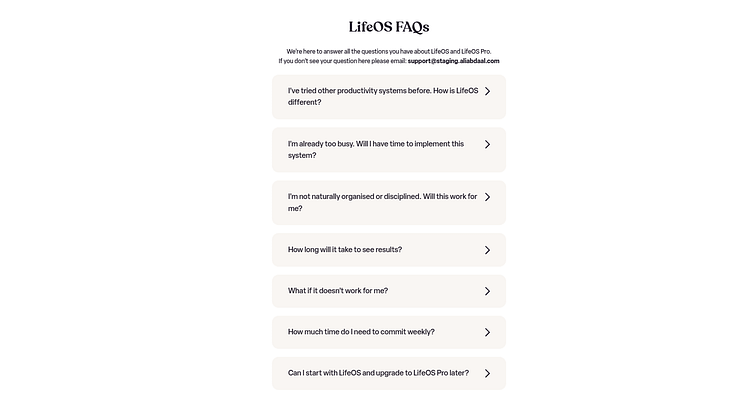
The page closes with a clean call to action and subtle urgency. Nothing overhyped. No false scarcity. Just a confident, clear offer.
🔑 Key Takeaways from Ali’s LifeOS Landing Page
- Name your framework. LifeOS isn’t just a course — it’s a named, proprietary system. That builds perceived value instantly.
- Teach before you pitch. The “psychology of productivity” section educates and primes the reader to believe in the solution.
- Use visual structure. Icons, short blurbs, and white space make this a joy to scroll.
- Be upfront about pricing. No one wants to dig for the cost. Transparency builds trust.
- Handle objections in advance. The FAQs are smart, specific, and well-worded.
Example 4: Chris Do – Brand Messaging Kit Landing Page
🧭 Type: Digital Product (Downloadable Kit)
🎯 Offer: Brand Messaging Kit – A Framework for Sharpening Your Brand Voice
TL;DR: Why Chris Do’s Brand Messaging Kit Page Works So Well
- Right up top, you get everything you need: the product name, a shot of Chris on stage (great trust-builder), the price, and exactly what’s inside the kit. No fluff. No build-up. Just clear value, front and center.
- Instead of a long personal story, Chris keeps things tight — he explains the importance of messaging with a quick nod to brand psychology, not hard-sell tactics. It positions the offer as thoughtful and strategic without feeling forced.
- There’s a short “From the Instructor” section that adds just enough personal touch to build credibility. You get a glimpse into Chris’s mindset shift — why messaging clicked for him — and it makes the product feel more grounded in real-world experience.
- The visuals do most of the heavy lifting: workbook mockups, tidy layout, and zero clutter. It’s skimmable, scrollable, and easy to say yes to — especially for buyers who already know they need help with their brand voice.
This page doesn’t shout. It doesn’t oversell. It trusts the offer to land — and that confidence makes it convert.
This is one of the most straightforward product pages I’ve reviewed — and I actually mean that as a compliment. Chris Do (founder of The Futur) knows exactly what this offer is, and he doesn’t dress it up in unnecessary copy. The landing page for the Brand Messaging Kit does a great job of staying focused, clear, and conversion-minded — especially for a lower-ticket, high-value resource.
The top section hits fast:
A large hero image of Chris on stage (great move — always show yourself in your element), a prominent product title, the price, and a crystal-clear list of what’s included. No distractions. No build-up. Just: “Here’s the product. Here’s the value. Here’s how to get it.” This kind of delivery works well for digital kits where the buyer already has a pain point and wants a solution *now.*
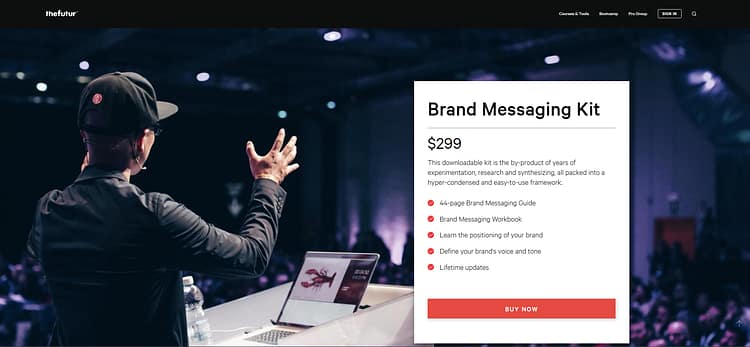
Then we move into some visual context. I appreciate how they didn’t default to a long emotional story — instead, they show the actual workbook and explain *why* messaging matters. The “Why start with why?” section is short but grounded in brand psychology, which helps give this offer more credibility. It's subtle positioning, not hard-selling.
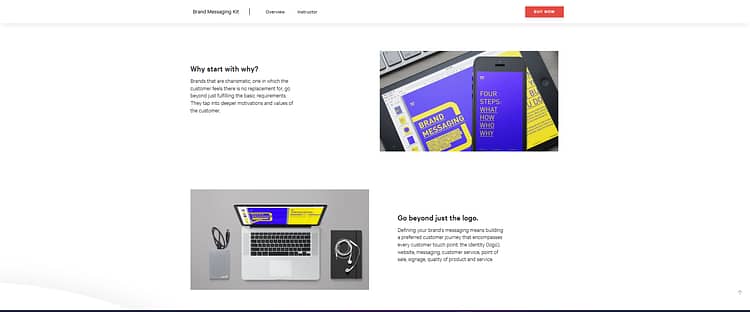
The next content block is one I always recommend creators include: “From the Instructor.” Chris writes personally and openly about how he used to believe visuals alone were enough, and how asking the right questions changed the way he approached brand messaging. Even though it’s short, it adds a layer of trust — and it reinforces that the kit is the product of lived experience, not just theory.
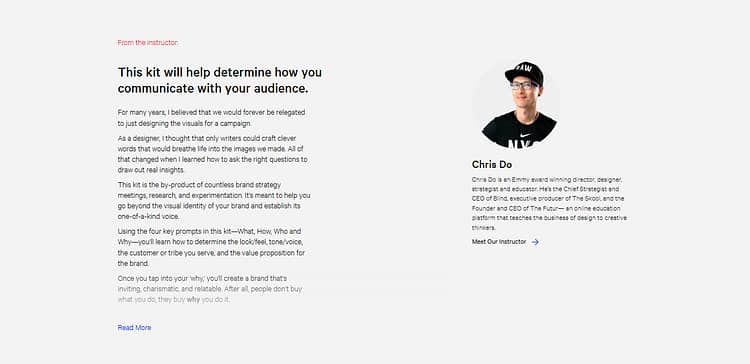
The visuals continue to do a lot of heavy lifting. Mockups of the materials, clear headers, and generous white space keep the page readable. There’s no endless scroll, no hypey urgency — just a final call to action and you’re done.
It’s minimal. It’s confident. It works.
🔑 Key Takeaways from Chris Do’s Brand Messaging Kit Page:
- Lead with clarity. The page opens with everything a potential buyer needs to make a decision. No fluff.
- Visual credibility matters. Real photos, mockups, and a speaking shot establish trust and authority fast.
- Instructor voice builds connection. Even a short personal note can go a long way in making your product feel real.
- No need for drama. Not every product needs a sweeping sales page. When the offer is practical, the copy should be too.
- Price transparency converts. $299 is front and center — no hiding, no bait-and-switch, and no pressure tactics.
Example 5: Chillpreneur – Creator Archetype Quiz Funnel
🧭 Type: Quiz Funnel → Coaching Program
🎯 Offer: Influential AF Academy – A Self-Expression Coaching Program for Creators
TL;DR: Why Chillpreneur’s Quiz Funnel Pulls Its Weight
This one breaks the mold — and that’s exactly why it works.
- It starts with you, not them:Instead of pitching an offer upfront, Chillpreneur leads with a quiz: “Discover Your Creator Archetype.” It’s engaging, introspective, and sneaks in value before asking for anything in return. The opt-in doesn’t feel like a form — it feels like the next logical step.
- Personalization powers the pitch:Your quiz result unlocks a tailored profile (mine was “The Conversationalist”) that genuinely feels useful — not filler. And because the language reflects your style, the offer that follows doesn’t feel random. It feels aligned.
- Skip the scroll — go straight to action:There’s no long sales page. The call to action sends you directly to the checkout. A bold move, but one that works when the pre-sell is baked into the experience. It’s trust-by-design.
If you’re a coach or creator working with identity, content, or self-expression, this is a funnel worth studying — not just for how it looks, but how it *feels* to go through.
Chillpreneur does their thing differently — *way* differently. From the second you land on their site, it’s loud, layered, and a little chaotic. For some people, that might feel like too much. But for creatives? That contrast is magnetic. It’s personality-forward, and that’s kind of the whole point.
Instead of leading with a traditional landing page, they let *you* do the talking — via a quiz.
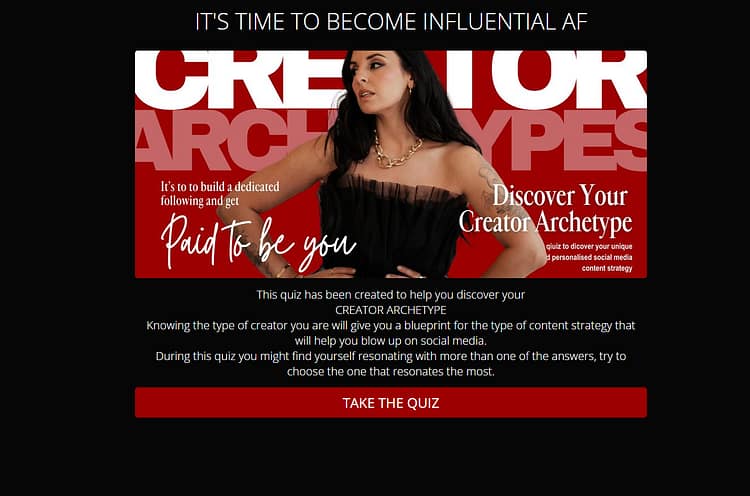
The “Discover Your Creator Archetype” quiz is their gateway to everything. It's designed to help you figure out your personal content style and how to lean into it on social media. The questions are fun, but not shallow — they make you think. And once you're done, you’re asked for your email in exchange for the results. That’s the opt-in moment, cleverly disguised as curiosity.
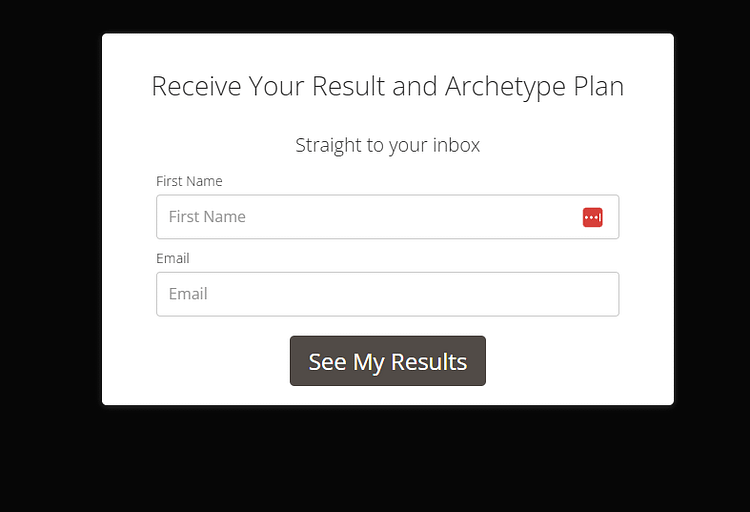
Once you hit submit, you get a surprisingly detailed profile delivered via email. My result? The Conversationalist. The report comes with a tone-of-voice breakdown, content creation tips, and examples — plus a CTA to join the Influential AF Academy.

But here’s the twist: that CTA doesn’t send you to a longform sales page. It goes straight to a checkout page. Pricing, offer summary, and a payment form. No fluff. No scroll. Just: here’s what it costs, are you in?
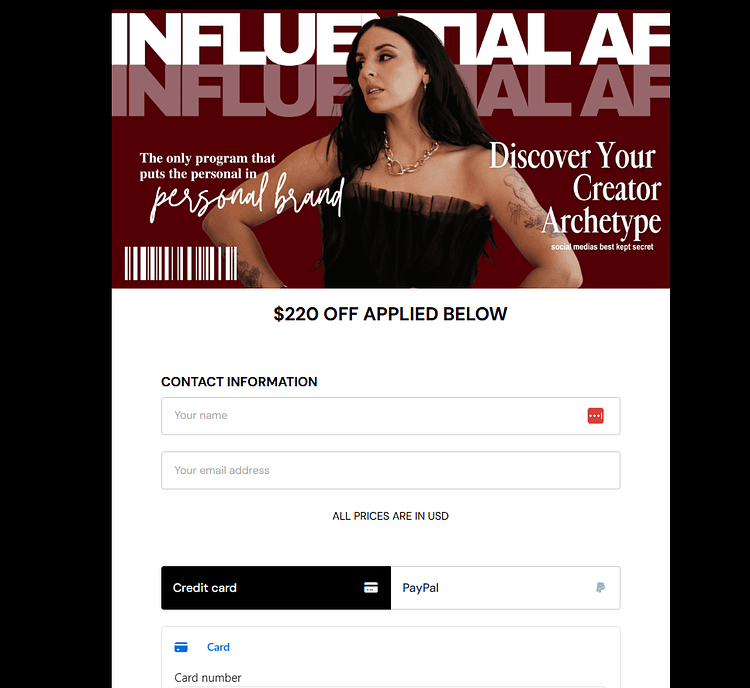
That’s a bold move. But in context, it works. If someone’s gone through the quiz and felt seen by the results, they’re already sold on some level. And for everyone else? Chillpreneur now has their email — and their archetype. Meaning every follow-up email can speak to that person’s specific style, doubts, and desires.
It's lean, it’s gutsy, and it’s creative funnel building. Not for the faint of heart — but definitely worth experimenting with if you’re targeting personality-driven creators.
🔑 Key Takeaways from Chillpreneur’s Funnel
- Turn personality into a lead magnet. The quiz works *because* it’s rooted in identity. People love learning about themselves — and then seeing what to do with that insight.
- Ditch the traditional funnel (if it makes sense). No landing page, no long-scroll pitch. It’s quiz → results → buy. High risk, high payoff. Test before going all in.
- The visuals are bold by design. They’re not trying to win design awards — they’re trying to attract the right kind of client. If you’re serving a creative audience, don’t be afraid to color outside the lines.
- Use email follow-up intentionally. Once someone’s taken the quiz, you’ve got personalized data. Use that to segment, tailor your messaging, and deepen the relationship over time.
- Even chaos needs structure. Behind the quirk and contrast is a very clear funnel with a purpose: convert cold traffic into warm leads, then into bold buyers.
Want to learn how to create an engaging quiz funnel? Check out this step-by-step guide right here.
Example 6: Listings Lab – Application Page Funnel
🧭 Type: Premium Coaching Program (Call-Based Offer)
🎯 Offer: A Framework for Scaling a Real Estate Business to Multi-Six or Seven Figures
TL;DR: Why The Listings Lab Application Funnel Works So Well
This page isn’t trying to sell to everyone — and that’s the whole point.
- It’s not a checkout, it’s a filter.The Listings Lab isn’t selling a quick fix. It’s offering a premium coaching experience — and they make you *apply* to join. That alone reframes the offer as high-value. You’re not just buying into a program. You’re asking to be considered.
- The funnel respects the buyer’s effort.Booking a call is a bigger ask than downloading a freebie. This funnel meets that ask with proof, presence (video!), and real talk. It doesn’t just say “trust us” — it gives you reasons to.
- Positioning happens through process.From the detailed form to the strategic copy, every part of this page signals: “We work with a specific kind of person.” That scarcity isn’t artificial — it’s built into the structure. If you’re the right fit, the funnel makes you feel seen. If you’re not, you self-select out.
If you’re offering a high-touch, transformation-based coaching program, and you’re tired of the usual sales page grind, this kind of call-first funnel is worth considering — especially when your value is in the conversation, not just the content.
The Listings Lab does things a little differently — and it works.
Their core offer isn’t a course or a freebie — it’s a call. You get on the phone, talk it through, and see if the program’s a fit. Which makes sense. Not every business should be sold through a checkout button. Sometimes, the offer itself needs to be filtered — and that’s exactly what this funnel is designed to do.
It starts on the homepage with a strong hero:
“Build a sustainable multi-six or seven figure real estate business — without burning out or relying on outdated marketing tactics.”

Clear promise. Clear CTA. When you click the “Book a Call” button, it leads you to a landing page — and that choice is intentional.
Instead of dropping you on a form, they take you through a proper sales experience. That matters — because this is a high-effort offer.
When the action you’re asking someone to take requires more from them (a call, a big investment, or a time commitment), you need to earn it. That means building trust, showing proof, and giving people enough detail to feel safe opting in.
The landing page kicks off with another hero, this time reframing the promise as “the most effective framework in real estate marketing to grow and scale your business.” It’s direct, but also ambitious — and sets the tone for what follows.
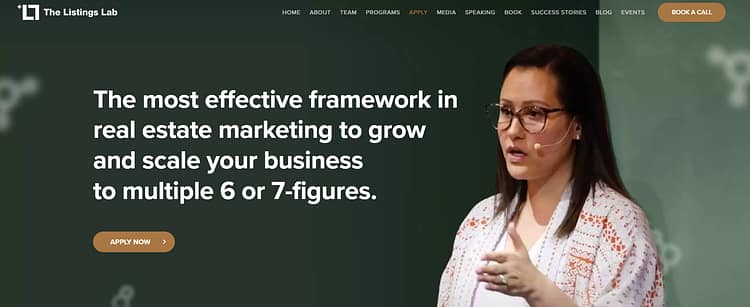
Next, they speak straight to the pain points:
Are you worried about where your next client is coming from?
Are you tired of working hard without seeing consistent results?
This follows the classic problem–agitation–solution model, but it doesn’t feel templated. It feels honest — and that matters in a market where every other funnel sounds the same.
Then there’s a short video. And here’s where I always recommend putting in the extra work:
If your offer requires more effort from the user — like booking a call, making a big payment, or committing to a serious transformation — you should include a video.
People want to see who they’re working with. They want to hear your voice. They want to know there’s a real person on the other side. The Listings Lab gets that.

Further down, you get a clear summary of the program: what it is, what it includes, and how long it runs. In this case, it’s designed to help you dominate your marketplace in 90 days — which is another smart move.
Timeframes ground transformation in something tangible.
They help people imagine what could be possible by a specific point in time — and that makes commitment feel easier.

The testimonials here are strong. Some are written, others are on video — and those video ones do a lot of heavy lifting. A real person speaking about their transformation creates trust faster than any long paragraph ever could.
And then we get to the form — and this is where the filtering starts.
This isn’t your typical first name–last name–email setup. It’s an application form.

You’re asked about:
It might seem like they’re just trying to get to know you — but this is a strategic filter. The Listings Lab clearly works with a specific kind of client. This form helps them spot whether or not you’re that person.
And beyond that, having a form like this adds prestige. It says: this isn’t for everyone. You don’t just buy — you apply.
🔑 Key Takeaways from the Listings Lab Funnel
- Not all offers need a “buy now” CTA — booking a call can be more strategic (especially for high-ticket or selective programs)
- Use full landing pages before application forms — let people understand what they’re saying yes to
- For high-effort actions (calls, bigger price points, serious commitments), include a video — let people see you
- Speak clearly to the real pain points — don’t just “paint the dream,” show that you understand the struggle
- Anchor your program in a clear timeframe to build confidence (e.g. 90 days)
- Use video testimonials where possible — they convert better than blocks of text
- Application forms should act as filters, not just intake forms — they help you qualify leads and elevate your brand
Example 7: Natalie Ellis – Webinar Funnel
🧭 Type: Webinar → Email Nurture → Paid Offer
🎯 Offer: A 5-Step Playbook to Start or Scale a Freedom-Based Business™
TL;DR: Why Natalie Ellis’s Webinar Funnel Works Without the Hype
This funnel doesn’t rush. It guides.
- It starts with one clear action:The homepage isn’t trying to do everything. It does one thing well — pointing people to the masterclass. That clarity instantly builds trust and makes navigation frictionless.
- The messaging speaks directly to desire:“Create more time, make more money.” It’s a promise wrapped in simplicity. Paired with a clean design and CTA, the visitor knows what they’re getting and why it matters.
- The rest of the funnel is invisible — by design:There’s no long sales page or aggressive pitch. You register for the webinar, and the nurture begins in the background. Emails are personalized, the tone stays helpful, and the actual offer only shows up once you’re ready to hear it.
If you’ve ever felt like your sales page was doing too much too soon, this is a great example of pacing. Natalie’s funnel builds interest, not pressure — and in today’s trust-driven market, that’s what works.
Natalie Ellis does things simply — but intentionally. And it starts with the homepage. This isn’t a cluttered, multi-offer hub. It’s a pointer. The homepage exists to drive traffic to one clear destination: the free masterclass.
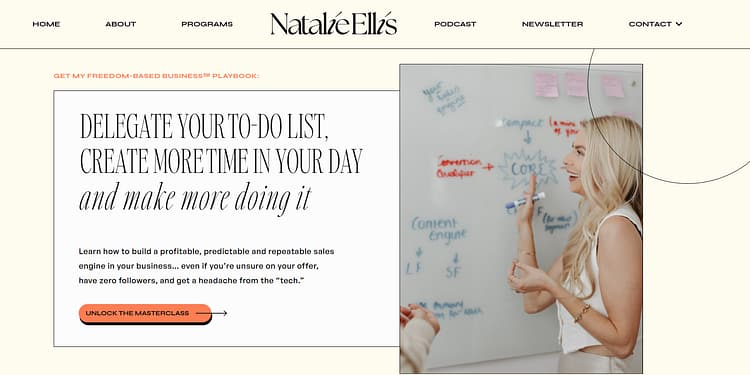
That’s a smart move, especially if your business has multiple offers behind the scenes. Instead of overwhelming the visitor, you guide them toward the best starting point — a webinar designed to nurture trust and capture leads. If you’re trying to warm people up to a paid program, this is how you do it.
The homepage headline is strong: “Delegate your to-do list, create more time in your day, and make more doing it.” That messaging taps directly into the freedom and income desires of the target audience. Paired with a clean “Unlock the Masterclass” CTA, the funnel starts with clarity and minimal friction.
Once you click through, you land on the webinar registration page. The headline hits: “Your 5-Step Playbook to Start or Scale a Freedom-Based Business™.” It promises structure, not fluff.
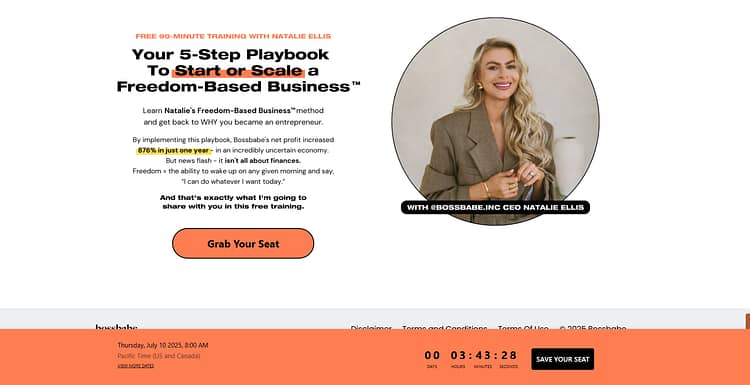
There’s a quick intro to Natalie as the BossBabe co-founder, and a standout stat: an 876% profit increase. No drawn-out testimonials or proof walls — just a clear outcome that earns attention.
Then comes the countdown timer — a soft urgency tactic. You’re shown the next available webinar slot, creating forward motion without being pushy. The registration form is short: name, email, and session time. But this is where the real funnel begins. Behind that simple opt-in is a well-oiled lead gen machine. You enter your details, attend the masterclass, and start receiving emails — tailored to your interest and behavior.
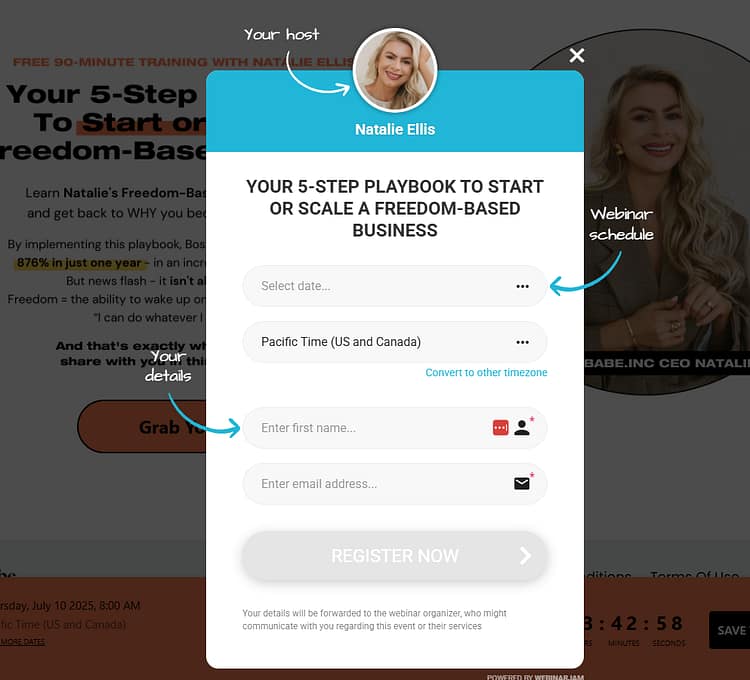
There’s no “Buy Now” page, no long sales letter upfront. Because for this funnel, the selling happens later. The webinar does the warming. The emails do the nudging. And eventually, you’re invited into the paid BossBabe ecosystem — likely a course, membership, or group coaching offer.
It’s simple. It’s user-friendly. And it’s built on trust-first marketing.
🔑 Key Takeaways from the Natalie Ellis Funnel
- Use your homepage to point to one primary offer — it reduces overwhelm and increases action
- Webinars are still powerful when paired with strong positioning and lead capture
- Short landing pages can convert — especially when paired with stats and clean design
- A single outcome-based stat can replace lengthy testimonials
- Countdown timers create soft urgency that nudges action without pressure
- Lead gen is the real goal — the webinar warms them up, the emails do the selling
- Simple structure + strong funnel = effective conversion without complexity
Yes, You Can Build Pages Like This — Even If You’re Not a Designer
These pages look sleek and strategic for a reason — they’re built to convert. But that doesn’t mean you need to hire a designer or spend weeks figuring out how to build one from scratch.
When I first tried creating pages like these, I spent way too long fighting with clunky builders and trying to get things to “look right.” And even then, it still felt off — like I was forcing someone else’s template to fit my offer.
I came across Thrive Suite through a former client (and I’m genuinely grateful to him for that). It’s the only tool I’ve used that actually feels built for marketers. I can design fully custom landing pages — sales funnels, freebie opt-ins, application forms, you name it — and make them look exactly how I want without touching a line of code. Everything is drag-and-drop, and the templates are actually conversion-focused (not just pretty placeholders).
If you’ve been sitting on an offer because the tech feels overwhelming — this removes the roadblock. I’ve launched full funnels in a weekend using Thrive. Once it’s set up, it’s yours to tweak, test, and scale however you want.
It’s hands-down one of the best investments I’ve made in my business.
Most Common Questions About Coaching Landing Pages
Real questions people ask when trying to create an effective coaching funnel.
A coaching landing page is a focused, standalone page designed to convert visitors into leads or clients — usually by offering a freebie, booking a call, or promoting a specific program. Unlike a homepage (which gives an overview of your brand), a landing page is built around one clear action.
Start with a strong headline and subhead, speak to your audience’s pain points, offer a clear transformation, and include a bold call-to-action (CTA). Use sections like testimonials, program highlights, and video to build trust and boost conversion rates.
Focus on results, not just features. Use clear, emotionally-resonant copy that answers: “What’s in it for them?” Keep it conversational, break up your text for readability, and use bullet points to highlight benefits.
You don’t need to hire a developer. With drag-and-drop tools like Thrive Architect, you can easily build beautiful, high-converting coaching pages — even if you’ve never touched code. Templates and visual editing make the process simple and intuitive.
Inside platforms like Thrive Suite, Leadpages, or Kajabi, you’ll find pre-designed templates made specifically for coaches, course creators, and consultants. Look for templates that are mobile-optimized and built around lead generation goals.
Use tools like Google’s Mobile-Friendly Test or simply view your page on different devices. Most modern page builders like Thrive Architect allow you to preview and customize mobile layouts directly — no guessing required.
It depends on your funnel. For high-ticket coaching programs, a “book a call” CTA can work best. For list-building, go with a freebie or quiz. The key is matching the offer with your ideal client’s level of awareness and readiness.
Track metrics like conversion rate (how many people take action), time on page, and bounce rate. A/B test headlines, button colors, or CTA placements. Tools like Thrive Optimize or Google Analytics can help you see what’s working and what’s not.
Only if it makes sense for your strategy. For premium coaching offers, many coaches use application-based funnels and reveal pricing later. For lower-ticket offers or courses, upfront pricing can reduce friction. Either way, always emphasize the *value* first.
Absolutely. Thrive Architect is made for non-techies. You can customize layouts, add testimonials, embed videos, and connect to your email marketing tool — all without writing a single line of code. It’s ideal for solo coaches and small teams.
Final Thoughts: Building a Coaching Landing Page That Actually Converts
Great coaching landing pages don’t try to do everything — they guide visitors toward one clear step. Whether that’s booking a call, signing up for a training, or downloading a freebie, clarity is what drives conversions.
Once you know your goal, structure the page around it. Use a proven layout, write copy that speaks to outcomes (not just motivation), and show real social proof. Repeat your CTA at least three times, and make sure it’s impossible to miss.
If you're using Thrive Suite, you already have everything you need. You can start with a coaching-specific template, edit it easily, connect it to your email list, and even run A/B tests with Thrive Optimize to improve performance over time.
The tech doesn’t need to hold you back. If your offer is strong, Thrive gives you the tools to match.

